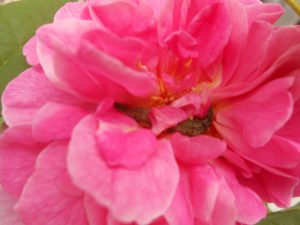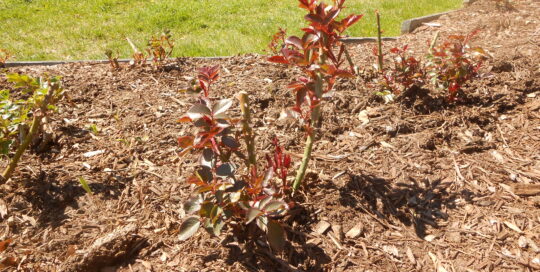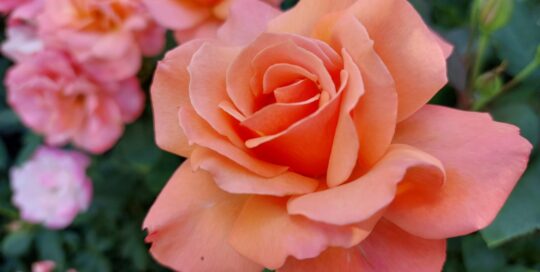Late Season Caterpillar Invasion!
Views: 1635

We just returned from a wonderful vacation on Cape Cod. We were fortunate to be visited by friends and family and had almost two weeks to relax near the whales, seals, and great white sharks swimming just beyond the outer beaches. I had sprayed my gardens about a week before we left, so I felt confident my roses would be just fine, and my daughter offered to keep my hanging petunias at her house where she would water them daily and avoid a late season caterpillar invasion.
We had twelve fun-filled days at the Cape, the last few with our rose friends John Mattia and Baldo Villegas, who had come all the way from California! The last week brought us a lot of rain, so we opted to come home on Thursday instead of Friday. We brought Baldo home with us so we could drop him off at the airport on Saturday morning. Baldo is a super-fun and interesting guy, and I love it when he comes to visit. He worked for many years as entomologist for the state of California and is my favorite bug man. He likes to explore my gardens and take pictures of bugs they just don’t have on the west coast.
Returning Home
After we got home, I called my daughter to let her know we’d be coming for the petunias on Sunday and she was upset. She said, ‘Mom, I’m no good with potted plants! These don’t look anything like they did when you dropped them off!’ I told her not to worry and that they would be fine. Baldo headed out to the garden on Friday morning and discovered a plethora of caterpillars who had eaten the tops of the rose stems, leaves and the buds. It was a late season caterpillar invasion!! There were hundreds of them gorging themselves out there! The damage almost looked like deer browsing, and Baldo said the larvae looked like some kind of a budworm. He promptly squished them with his fingers and used his tee shirt to wipe the goo off. I never knew tee shirts were bug-goo napkins before…
Tobacco Budworms
Bob went to pick up my petunias on Sunday morning, and when I went out to check them, I noticed big, fat, juicy, creepy-looking caterpillars all over them! I grabbed my camera and went back out to take pictures. These larvae made me really nervous because in my 40 years of rose gardening, I have never seen so many caterpillars at the end the growing season.
Finding more information
I came in and sent pictures and an email to my friend, Rich Cowles, who is the entomologist at the CT Agricultural Experimental Station’s Valley Lab in Windsor. He wrote me back, identified my worms as Tobacco Budworms, and sent me a couple of links to check out here and here.
Here were pages of information about these caterpillars! They are pests to cotton and tobacco in the South. They are really a southern and western pest, but during the season, they move north with the heat. Also, they are legendary petunia gobblers. Go figure…this was our hottest summer ever, and I live right in Connecticut’s tobacco valley! The females lay their eggs on blossoms, fruit, and terminal growth, and they can deposit 300-500 eggs each! The eggs hatch faster in hot weather, and ditto to the caterpillars’ growth.
Here at home, our first week away, the temps were over 95 most of the time…that’s why the larvae grew so fast. The bodies have microspines on them. Parasitic wasps who try to lay their eggs on them get stunned by a poisonous substance the caterpillar produces in its mouth and coats its body with. If eggs are deposited, the worms will crunch and crush them, and these budworms can also be cannibalistic. I felt I needed to get rid of them as soon as possible as I was afraid of another attack next spring, but Rich let me know that they would not be able to overwinter here with our cold weather to come.
A Last Spraying
Rich also let me know that it was late in the season to use biologics like Bt. So, I sprayed insecticide, two kinds of fungicide as downy mildew had also arrived (our hot season turned very chilly overnight), and a miticide (to kill any eryiophyiid mites which carry rose rosette virus). I sprayed on an overcast and cool morning, when there were no bees or dragonflies about. Rich had told me it was difficult to kill these at this large stage, but I gave it a try.
The next morning, I went back out to check on their status. I brought a set of garden forceps that Baldo had given me a few years ago, pulled the caterpillars that were left off my plants, and dropped them on the ground. The last thing they saw was the sole of my shoe dropping on top of them with a squish. I just couldn’t stand the thought of hand-picking these micro-spiney, poison-coated critters! So much for thinking I was finished in my rose garden until pruning time!
Meet Marci Martin
Marci Martin has loved roses for as long as she can remember. From the time she was a little girl, she was fascinated with how…
Marci's Recent Posts

March: An Early Start in the Rose Garden This Year








